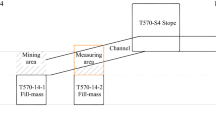Abstract
The proposed prediction model for estimating the maximum rebound ratio was applied to a field explosion test, Mandai test in Singapore. The estimated possible maximum peak particle velocities(PPVs) were compared with the field records. Three of the four available field-recorded PPVs lie exactly below the estimated possible maximum values as expected, while the fourth available field-recorded PPV lies close to and a bit higher than the estimated maximum possible PPV. The comparison results show that the predicted PPVs from the proposed prediction model for the maximum rebound ratio match the field-recorded PPVs better than those from two empirical formulae. The very good agreement between the estimated and field-recorded values validates the proposed prediction model for estimating PPV in a rock mass with a set of joints due to application of a two dimensional compressional wave at the boundary of a tunnel or a borehole.
Similar content being viewed by others
References
LEI W D, TENG J, ZHAO J, et al. A study on transmission ratio (T n) in the radian direction normal to joints in 2-D compressional wave propagation in rock masses[J]. Journal of University of Science and Technology Beijing, 2006, 13(3):199–206.
LEI W D, TENG J, ZHAO J, et al. Numerical study on maximum rebound ratio in blasting wave propagation along radian direction normal to joints [J]. Journal of Central South University of Technology, 2006, 13(6): 743–748.
CHEN S G, CAI J G, ZHAO J, et al. Discrete element modeling of an underground explosion in jointed rock mass[J]. Geotechnical and Geological Engineering, 2000, 18(2): 59–78.
CHEN S G, ZHAO J, ZHOU Y X. UDEC modelling of a field explosion test[J]. Fragblast — International Journal of Blasting and Fragmentation, 2000, 4(2): 149–163.
LEE C B. Fracturing characteristics of Bukit Timah granite [D]. Singapore: Nanyang Technological University, 2002.
BIENIAWSKI Z T. Engineering classification of joint rock masses [J]. The Civil Engineer in South Africa, 1973, 15(12): 335–343.
SERAFIM J L, PEREIRA J P. Consideration of the geomechanical classification of Bieniawski[C]// Proceedings of International Symposium on Engineering Geology and Underground Construction, Lisbon: Portugal, 1983: 33–44.
HART R D. An Introduction to distinct element modeling for rock engineering[C]// HUDSON J A. Comprehensive Rock Engineering. Oxford: Pergamon Press, 1993: 245–261.
ZHAO J, HEFNY M A, ZHOU Y X. Hydrofracturing in-situ stress measurement in Singapore granite [J]. International Journal of Rock Mechanics and Mining Sciences, 2005, 42(4): 577–583.
ZHAO J. Construction and utilization of rock caverns in Singapore, part A: bedrock resource of the Bukit Timah granite[J]. Tunnelling and Underground Space Technology, 1996, 11(1): 65–72.
LEI Wei-dong. Numerical Studies on 2-D Compressional Wave Propagation in Jointed Rock Masses[D]. Singapore: Nanyang Technological University, 2005.
AMBRASEYS N R, HENDRON A J. Dynamic behavior of rock masses[C]// Proceedings of Rock Mechanics in Engineering Practice. London: John Wiley and Sons, 1968: 203–227.
WU T H. Soil Dynamics[M]. Boston: Allyn and Bacon, 1975.
Author information
Authors and Affiliations
Corresponding author
Additional information
Foundation item: Project(50278057) supported by the National Natural Science Foundation of China; project(2002CB412703) supported by the Major State Basic Research Development Program of China
Rights and permissions
About this article
Cite this article
Lei, Wd., Teng, J., Hefny, A. et al. Experimental study on prediction model for maximum rebound ratio. J Cent. South Univ. Technol. 14, 115–119 (2007). https://doi.org/10.1007/s11771-007-0023-2
Received:
Accepted:
Issue Date:
DOI: https://doi.org/10.1007/s11771-007-0023-2




